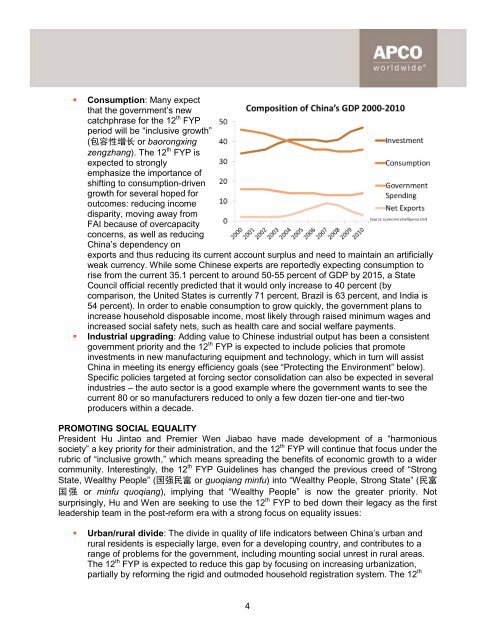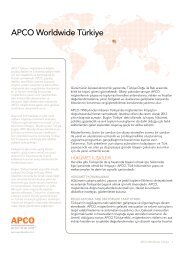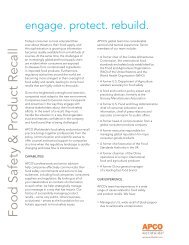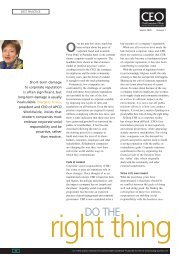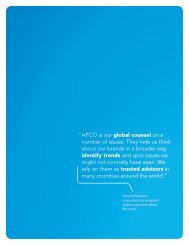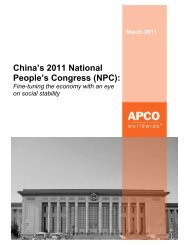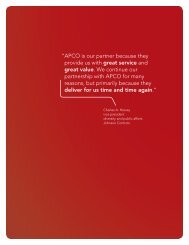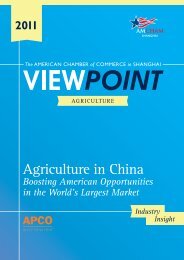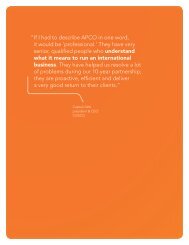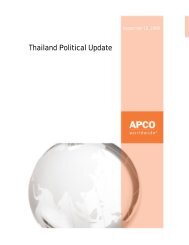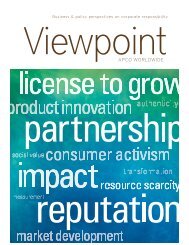China's 12th Five-Year Plan - APCO Worldwide
China's 12th Five-Year Plan - APCO Worldwide
China's 12th Five-Year Plan - APCO Worldwide
You also want an ePaper? Increase the reach of your titles
YUMPU automatically turns print PDFs into web optimized ePapers that Google loves.
Consumption: Many expect<br />
that the government’s new<br />
catchphrase for the 12 th FYP<br />
period will be “inclusive growth”<br />
(包容性增长 or baorongxing<br />
zengzhang). The 12 th FYP is<br />
expected to strongly<br />
emphasize the importance of<br />
shifting to consumption-driven<br />
growth for several hoped for<br />
outcomes: reducing income<br />
disparity, moving away from<br />
FAI because of overcapacity<br />
concerns, as well as reducing<br />
China’s dependency on<br />
exports and thus reducing its current account surplus and need to maintain an artificially<br />
weak currency. While some Chinese experts are reportedly expecting consumption to<br />
rise from the current 35.1 percent to around 50-55 percent of GDP by 2015, a State<br />
Council official recently predicted that it would only increase to 40 percent (by<br />
comparison, the United States is currently 71 percent, Brazil is 63 percent, and India is<br />
54 percent). In order to enable consumption to grow quickly, the government plans to<br />
increase household disposable income, most likely through raised minimum wages and<br />
increased social safety nets, such as health care and social welfare payments.<br />
Industrial upgrading: Adding value to Chinese industrial output has been a consistent<br />
government priority and the 12 th FYP is expected to include policies that promote<br />
investments in new manufacturing equipment and technology, which in turn will assist<br />
China in meeting its energy efficiency goals (see “Protecting the Environment” below).<br />
Specific policies targeted at forcing sector consolidation can also be expected in several<br />
industries – the auto sector is a good example where the government wants to see the<br />
current 80 or so manufacturers reduced to only a few dozen tier-one and tier-two<br />
producers within a decade.<br />
PROMOTING SOCIAL EQUALITY<br />
President Hu Jintao and Premier Wen Jiabao have made development of a “harmonious<br />
society” a key priority for their administration, and the 12 th FYP will continue that focus under the<br />
rubric of “inclusive growth,” which means spreading the benefits of economic growth to a wider<br />
community. Interestingly, the 12 th FYP Guidelines has changed the previous creed of “Strong<br />
State, Wealthy People” (国强民富 or guoqiang minfu) into “Wealthy People, Strong State” (民富<br />
国强 or minfu quoqiang), implying that “Wealthy People” is now the greater priority. Not<br />
surprisingly, Hu and Wen are seeking to use the 12 th FYP to bed down their legacy as the first<br />
leadership team in the post-reform era with a strong focus on equality issues:<br />
Urban/rural divide: The divide in quality of life indicators between China’s urban and<br />
rural residents is especially large, even for a developing country, and contributes to a<br />
range of problems for the government, including mounting social unrest in rural areas.<br />
The 12 th FYP is expected to reduce this gap by focusing on increasing urbanization,<br />
partially by reforming the rigid and outmoded household registration system. The 12 th<br />
4


